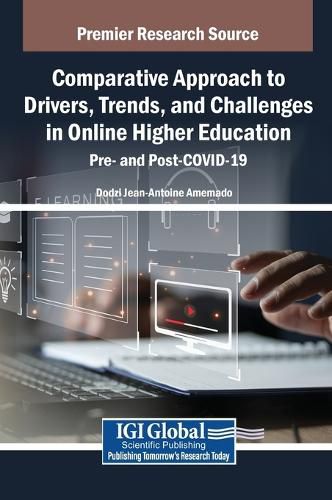Readings Newsletter
Become a Readings Member to make your shopping experience even easier.
Sign in or sign up for free!
You’re not far away from qualifying for FREE standard shipping within Australia
You’ve qualified for FREE standard shipping within Australia
The cart is loading…






This title is printed to order. This book may have been self-published. If so, we cannot guarantee the quality of the content. In the main most books will have gone through the editing process however some may not. We therefore suggest that you be aware of this before ordering this book. If in doubt check either the author or publisher’s details as we are unable to accept any returns unless they are faulty. Please contact us if you have any questions.
Online higher education has seen significant transformations in recent years, particularly in the wake of the COVID-19 pandemic. A comparative approach to understanding the drivers, trends, and challenges in online learning reveals a shift from pre-pandemic to post-pandemic periods. Before COVID-19, online education was seen as a supplementary option for non-traditional students, driven by technological advancements and demands for flexibility. However, the pandemic created a fast adoption of online platforms, making digital learning a central feature of higher education. This shift has shown greater academic accessibility and global reach, but reveals pressing challenges related to digital equity, quality of education, and student engagement. Examining these issues may highlight the evolving nature of online higher education and provides a framework for understanding its future trajectory. Comparative Approach to Drivers, Trends, and Challenges in Online Higher Education: Pre- and Post-COVID-19 explores new strategies and challenges in global online higher education. It offers insights into the motivations behind technological adoption in universities, the obstacles faced, and emerging trends across various regions. This book covers topics such as data science, digital technology, and blended learning, and is a useful resource for educators, computer engineers, academicians, researchers, and scientists.
$9.00 standard shipping within Australia
FREE standard shipping within Australia for orders over $100.00
Express & International shipping calculated at checkout
Stock availability can be subject to change without notice. We recommend calling the shop or contacting our online team to check availability of low stock items. Please see our Shopping Online page for more details.
This title is printed to order. This book may have been self-published. If so, we cannot guarantee the quality of the content. In the main most books will have gone through the editing process however some may not. We therefore suggest that you be aware of this before ordering this book. If in doubt check either the author or publisher’s details as we are unable to accept any returns unless they are faulty. Please contact us if you have any questions.
Online higher education has seen significant transformations in recent years, particularly in the wake of the COVID-19 pandemic. A comparative approach to understanding the drivers, trends, and challenges in online learning reveals a shift from pre-pandemic to post-pandemic periods. Before COVID-19, online education was seen as a supplementary option for non-traditional students, driven by technological advancements and demands for flexibility. However, the pandemic created a fast adoption of online platforms, making digital learning a central feature of higher education. This shift has shown greater academic accessibility and global reach, but reveals pressing challenges related to digital equity, quality of education, and student engagement. Examining these issues may highlight the evolving nature of online higher education and provides a framework for understanding its future trajectory. Comparative Approach to Drivers, Trends, and Challenges in Online Higher Education: Pre- and Post-COVID-19 explores new strategies and challenges in global online higher education. It offers insights into the motivations behind technological adoption in universities, the obstacles faced, and emerging trends across various regions. This book covers topics such as data science, digital technology, and blended learning, and is a useful resource for educators, computer engineers, academicians, researchers, and scientists.